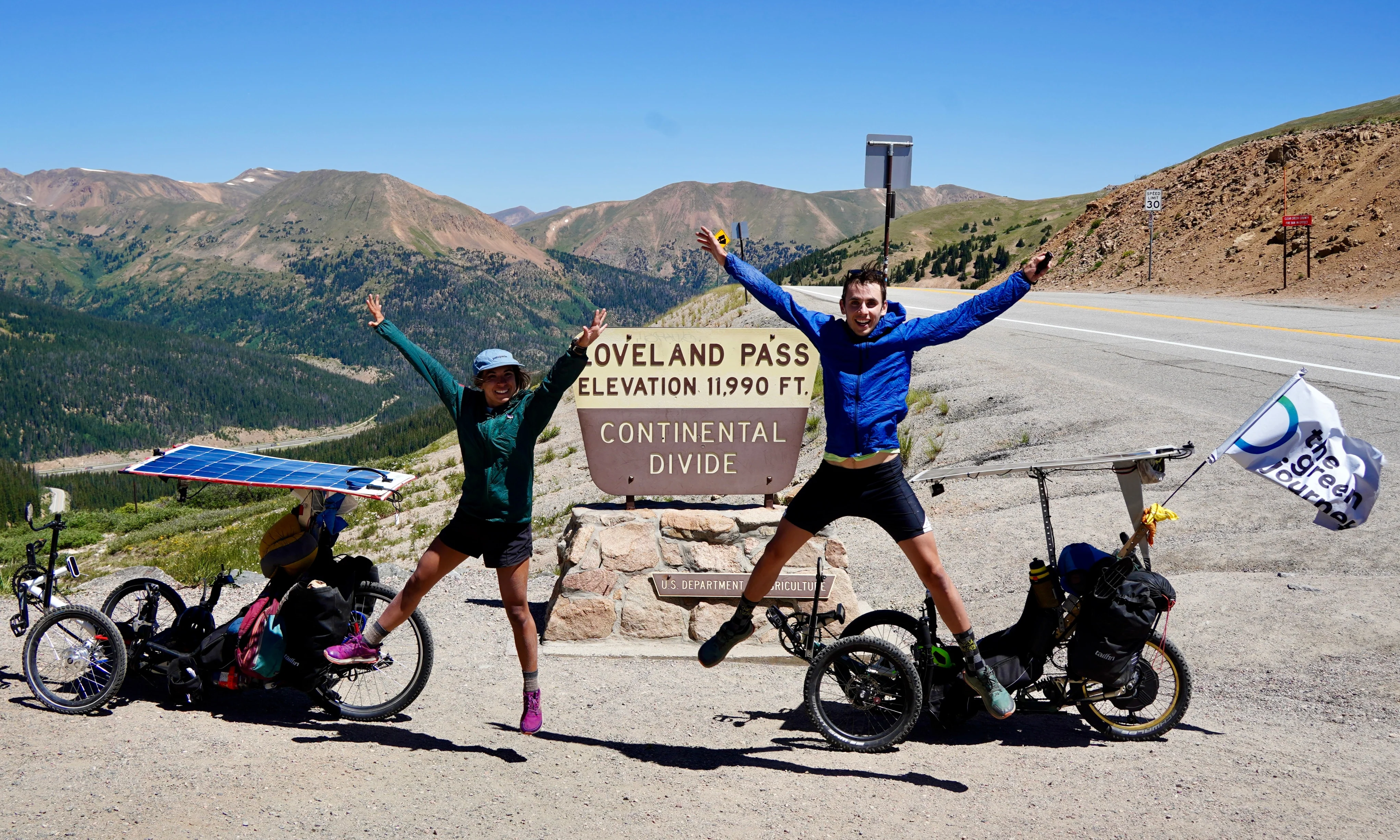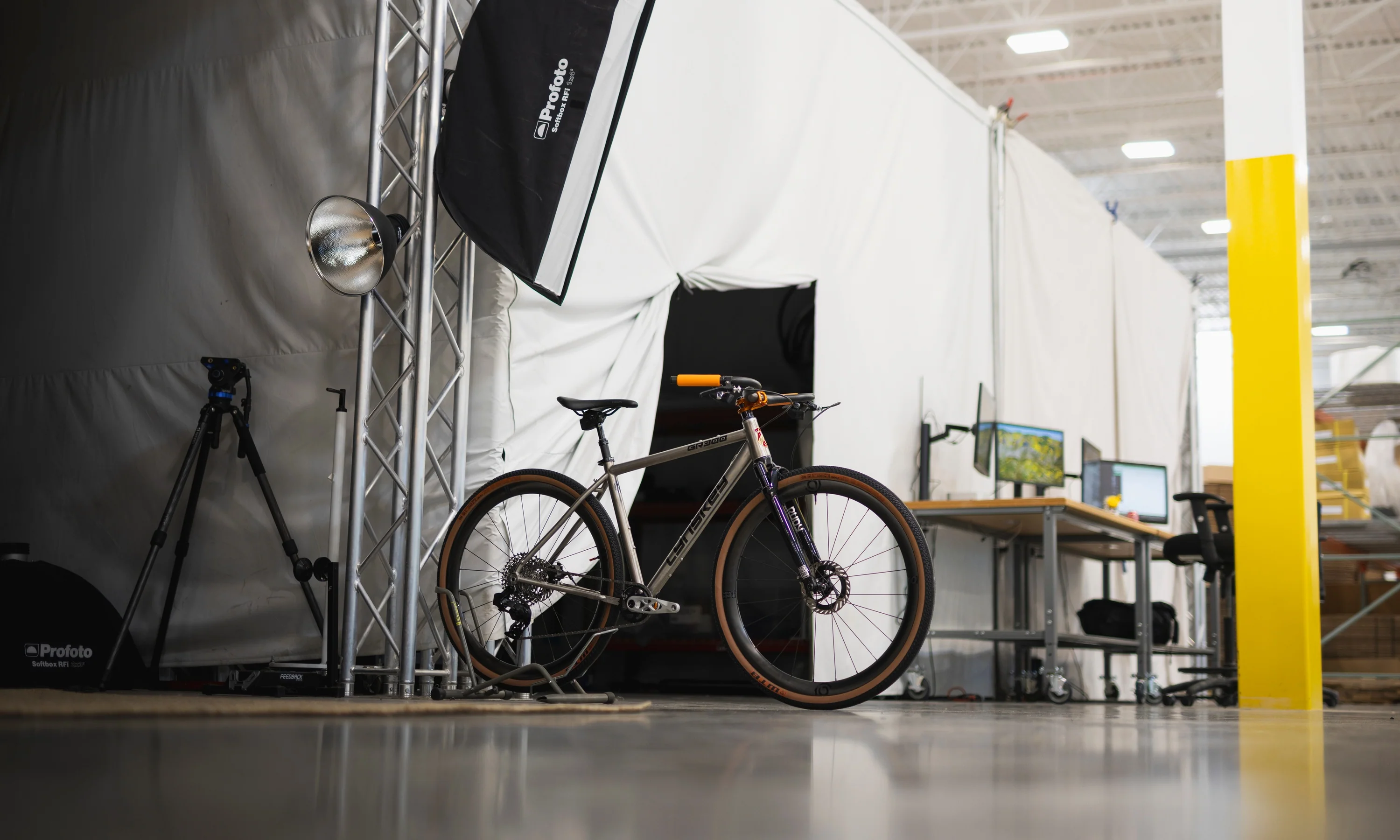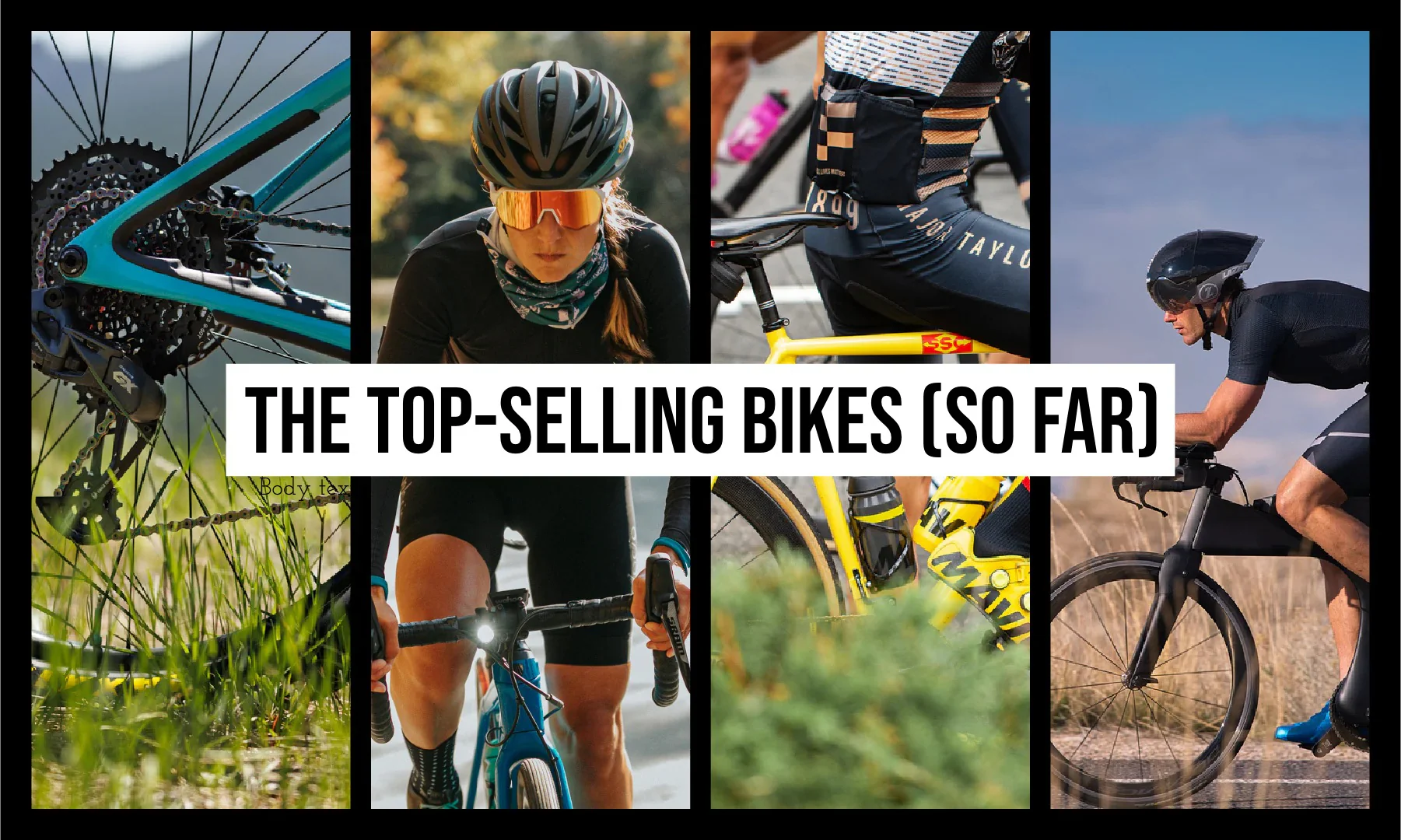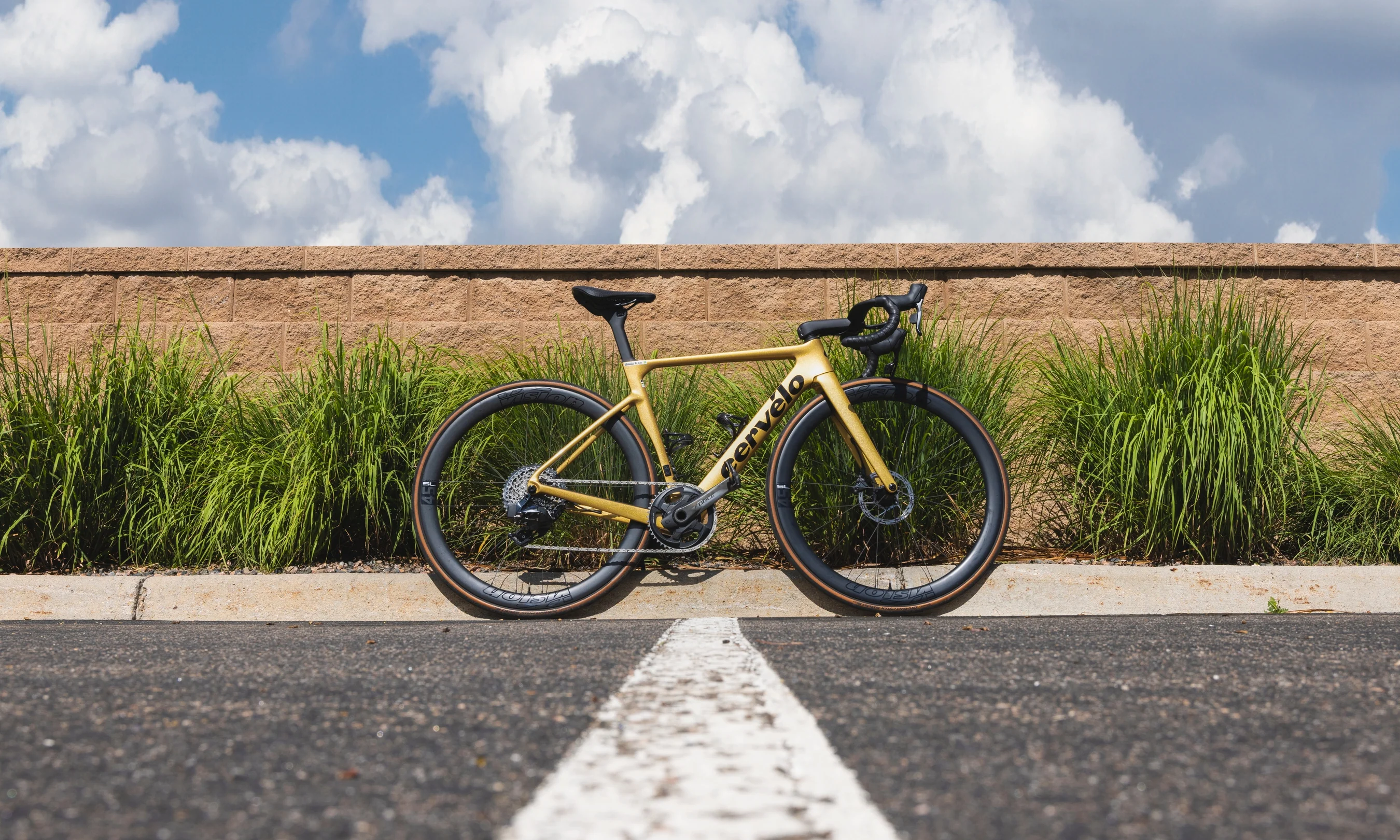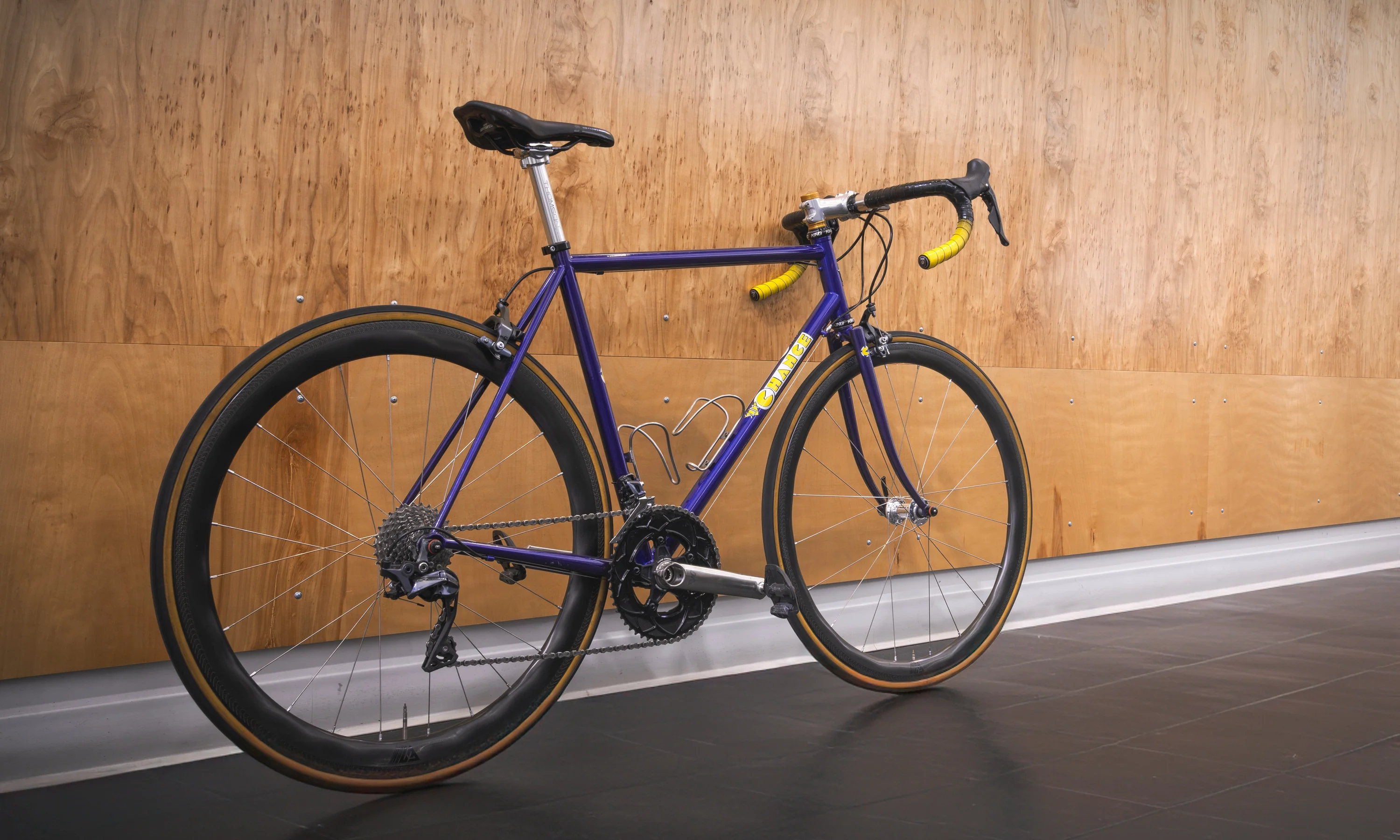Last week, I had the chance to meet Thomas Polo and Megan Routbort, co-founders of The Green Journey. They are currently undertaking an epic cross-country bikepacking trip on two of the most unique bikes I’ve ever seen. They’re riding from San Francisco to New York City — a 4,000-mile journey crossing 20 states — and they’re doing it on a pair of custom solar-powered trikes!
We’ve been following their journey on Instagram, and our Retail Operations Manager, Clint, invited them to stop by TPC when they reached the Colorado Front Range.

They made it!
By the time they arrived, they had ridden 1,400 miles and climbed 72,000 feet over 16 days. Their bikes had taken a bit of a beating while crossing the Continental Divide, so a couple of our Master Techs helped tune them up.
While they waited, I talked to Polo (his nickname is his last name, which is fairly common in France) and Megan to learn more about The Green Journey, their crazy custom bikes, and why they’re trying to cross the U.S. using the power of the sun.
Why Are They Doing This?

The Green Journey leads climate expeditions around the world. Essentially, Polo and Megan are riding solar-powered bikes across the U.S. to inspire and encourage people to do three things:
- Go solar
- Vote in favor of solar and renewable energy
- Bike more!
Polo: “When it comes to climate action, there's a lot we can agree and disagree on, but these are three things that can build a better, more sustainable future, and they are easy to do. The goal is just to get people to think about solar. We are not exactly promoting solar bikes — these are still prototypes.

“But when we talk to people, when people see us on the road, if they go back home and they start thinking oh, maybe I could go solar, or maybe I can have panels on my house, or advocate for community solar, then that's a win for us. That's the awareness we're trying to spread with this trip.”
Megan: “The bike is also just like a mini system. It has all the same components that a regular solar system would have — it's just one panel, one controller, and one battery. It's a good way to teach people that solar is actually pretty simple! It's a lot less complicated than any other type of energy, and that's what's really cool about it. You don't need much to go solar.”

Polo: “What we love about it is that it attracts all types of people. No one looks at you sweating your butt off out there in the desert and says, man, that seems like a bad person. We really wanted to build these solar bikes to spark conversation and just show people that it's possible to get across the U.S. with the power of the sun and your muscles.
“We are organizing events along the way too — like community bike rides. We are actually doing a ride tomorrow in Boulder followed by a talk about community solar and how you can get solar energy without putting panels on your house. We also do events with Patagonia across the country where we talk about the expedition and the organization.”
Megan: “We’re also really trying to connect people with organizations in their area that work on clean energy and bike advocacy so people can explore ways to volunteer or give. We're trying to spread the trip between tribal, rural, and urban communities, so we don’t just visit the big cities. It’s really about getting solar out there in all types of communities.”
About the Bikes Trikes: Steintrikes Wild One Series

We’re all fans of sustainability here at TPC. It’s why we like keeping pre-owned bikes on the road! Polo is also a fan of buying used, and his current “regular” bike was a Certified Pre-Owned bike purchased from TPC.
Likewise, their solar-powered trikes are built on secondhand platforms. They started with a couple of pre-owned Steintrikes Wild One full-suspension recumbent trikes which were then converted into E-trikes using hub motors from Electric Bike Outfitters (for Polo's) and Grin Technologies (for Megan's).

The trikes themselves are mostly stock, but the solar components are custom. Polo and Megan are using Allpowers 200-watt flexible solar panels — the type often used on RVs or camping trailers — connected to 400-watt MPPT solar controllers.

This charges a 48V 25Ah battery custom-built for their bikes because, unlike most common E-bike batteries, their batteries need to be able to charge and discharge at the same time.

The whole array is mounted to the bike on a custom frame Polo built using aluminum tubing. There’s also an option for plug-in charging if needed. The frame has LED lighting installed on the front and back to increase visibility.

The trikes can be propelled using pedal assist or a thumb throttle. Shifting is controlled by friction shifters. There’s also a “parking brake” — essentially a piece of elastic on the controls that engages the brakes. It keeps the trikes from rolling away and it’s helpful for mounting and dismounting the trike.

Polo’s trike has a 2x crank while Megan’s uses a 1x. I'm a 1x evangelist, so I'm a bit biased, but Megan's drivetrain had fewer issues than Polo's, who needed some extra work done on his finicky front derailleur.

At the back is a 9-speed Shimano Deore derailleur and cassette.
Polo’s trike uses a 26” rear wheel with 20” front wheels, while Megan’s has 20” wheels all around. They’ve equipped knobby tires to handle the many gravel and unpaved roads they’ll encounter across the U.S.

For extra comfort on rough and unpaved roads, there's suspension front and rear. Coil shocks are used all around. The front suspension uses a double wishbone design, which likely made it easy for the designers to control the kinematics.

The wheels aren’t tubeless-ready, so they’re relying on standard butyl tubes filled with sealant.

There’s a brake on each front wheel. Interestingly, Polo’s trike uses Sturmey-Archer drum brakes while Megan’s uses Avid BB7 mechanical disc brakes. After their trip over the Continental Divide, Polo’s drum brakes weren’t stopping too well. Unfortunately, we don’t carry the parts needed to service them (most bike shops won’t!). His plan now is to call ahead to a shop in Minneapolis or Chicago so they can order the parts ahead of time and have them ready when they arrive.
Do These Things Rip?

I tried riding Polo’s bike around the parking lot, and it was surprisingly nerve-wracking! It’s mostly because I’m not used to riding a loaded-up recumbent trike. It feels super low to the ground and I have no idea how far I can push it. Just getting into the seat felt awkward. Anytime I turned, I was worried about tipping over! I felt like a kid who’d just removed his training wheels.
There are multiple pedal assist levels, just like most E-bikes, but for any low speed maneuvers in the parking lot, the thumb throttle was much easier to use.
The suspension is surprisingly effective. It absorbs bumps so you barely feel them, but there isn’t much body roll when cornering. I can imagine that this would rip on gravel roads.
I’d probably get comfortable riding the trike with more practice. Polo and Megan mount and dismount their bikes easily, can quickly navigate tight turns, and even hop off the sidewalk. It’s really cool to see.

Megan: “I'm a slow descender, but I actually feel much more stable on this guy than I do on my road bike. They can get out of control though! Polo has a story about that.
Polo: “On the first day, I was like, okay, let's see what this beast can do. There was a downhill near Berkeley, and I decided to just go full-on down it. I hit 37 mph! Then there was a nice pothole that I hit with the right wheel. When I did, the left wheel lifted up and I was about to flip. I had to throw my body weight to the left to save it. I almost ended the trip right there!
“We have tipped over a few times, but usually it happens on or off a sidewalk, when you hit a curb. Fortunately, you're really near the ground so falls aren’t bad. In some ways, it feels safer than a normal bike. It just depends on what type of riding you're doing.”
How Effective is the Solar Charging?

Polo: “We use about 10wh per mile. When it’s really sunny, you get around 150 wh from the sun. So you can do 15 mph during the day. We’re trying to ride six hours a day to cover about 100 miles.
“We have to plug in to charge every now and then, usually when weather conditions are bad. It’s mostly because we’re trying to hit a daily distance of 100 miles. Solar only would be fine for a shorter daily distance. Elevation is tough because these bikes are really heavy. They’re around 90 pounds fully loaded up. You have to tone it back on climbs and use the legs more.”
Megan: “The hardest part of this whole thing has been getting the solar to work. We've done a lot of bike packing before and are pretty experienced with preparing and fixing our bikes, but getting the solar system and the electronic components to work was a whole different challenge. At the very beginning, we started with much smaller solar panels and we were running out of battery pretty quickly. Polo replaced the panels with these larger 200 W ones and now we don’t lose a single volt. We're excited about the new system!”
Polo: “We crossed the loneliest road in America, from Fallon, Nevada to Delta, Utah. It was 409 miles and there are 80-90-mile stretches where you don't see anyone at all. That was really hard because it was cloudy and rainy so the solar charging was pretty bad. We had to stay very, very conservative on the E-assist.
“I’ve only completely run out of power once, one mile before getting to a campsite. I had one mile of uphill to go and it took me half an hour. Range anxiety might be the toughest part of this trip.”
Ed Note: After this interview, Polo and Megan hit a new record in South Dakota — riding 120 miles on a sunny day with a strong tailwind and using only half of the battery. Weather has a huge effect on range!
What’s Been Great About Your Journey So Far?

Polo: “It's funny because people call these bikes so many different things. They're like, ‘Nice golf cart.’ ‘I like your car.’ ‘I like your sail.’ Some people definitely think the solar panel is there for shade or to catch the wind.
Megan: “Polo says he feels like Santa Claus. Everyone looks at you!”
Polo: “Generally, people have been super nice. We had an interaction near Lake Tahoe where highway patrol saw us and came up next to us. He thought we were in golf carts but when he saw the solar panels and realized what they were, we started talking about bike safety in Tahoe. He wanted to make sure people were giving us a lot of space!
 “One of the best things has just been meeting other people on the road and interacting with other members of the bike community. So many people have offered us warm showers or helped us fix flats. It's a journey that takes much more than two people to complete. In the first few days, the bikes were just not working. We had some pretty big technical issues and delays and a lot of people in our community in Berkeley came together to help us out. Random people see us — these two kids riding weird bikes — and they just want to help us. There’s an amazing feeling of mass support. The generosity and kindness we’ve encountered has been a huge highlight for me.
“One of the best things has just been meeting other people on the road and interacting with other members of the bike community. So many people have offered us warm showers or helped us fix flats. It's a journey that takes much more than two people to complete. In the first few days, the bikes were just not working. We had some pretty big technical issues and delays and a lot of people in our community in Berkeley came together to help us out. Random people see us — these two kids riding weird bikes — and they just want to help us. There’s an amazing feeling of mass support. The generosity and kindness we’ve encountered has been a huge highlight for me.  Megan: We’ve met so many cyclists and bikepackers who have opened their homes to us, which is an awesome experience. We're getting a lot of tips on the route from their experiences and we’ve learned so much from people who have done this type of trip before. We’re really excited about the Midwest because we met a couple that had bikepacked all across the Midwest and knew all the best places to visit.
Megan: We’ve met so many cyclists and bikepackers who have opened their homes to us, which is an awesome experience. We're getting a lot of tips on the route from their experiences and we’ve learned so much from people who have done this type of trip before. We’re really excited about the Midwest because we met a couple that had bikepacked all across the Midwest and knew all the best places to visit.
“Also, a major highlight is just that it works! We had pretty big doubts at first. It’s so awesome that we can cover incredible distances without really working that much!”

Polo: Despite the range anxiety, I do think riding through “The Loneliest Road in America” was also a major highlight.
What’s the Toughest Part of this Trip?
Megan: Definitely whenever it rains! But I think that's a lowlight for normal bikers too, right? But for us, we've got so many electronics to worry about. Yesterday we had some heavy rain and had to sit outside the gas station to wait it out while eating ramen. They're not super resilient in the rain right now, but someday…
Polo: Fenders would make a big difference. There are mounts, and we need to find fenders that will fit the small 20” wheels. Finding fasteners is the tricky part.
Stay Updated With The Green Journey

Polo and Megan spent a week in the Boulder area and now they’re continuing their journey across the country. Be sure to follow them for updates on their adventure!
Photos courtesy of The Green Journey

